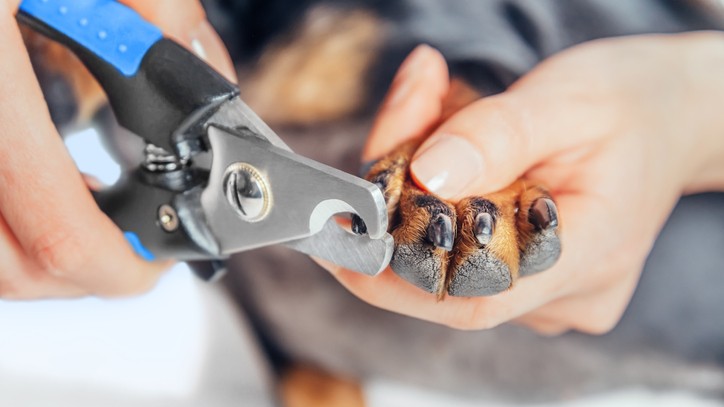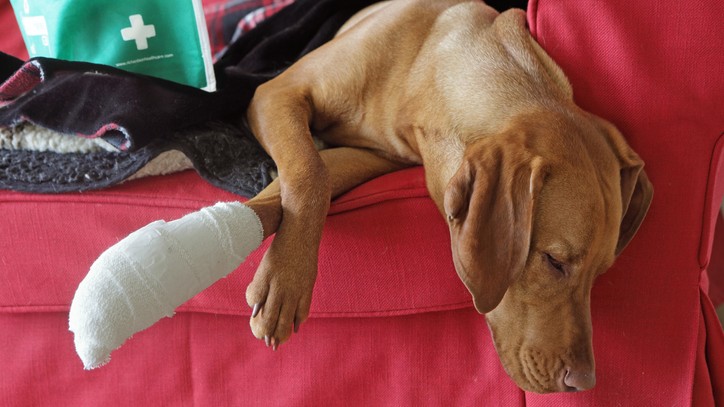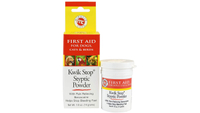How to stop a dog’s nail from bleeding
Want to know how to stop a dog’s nail from bleeding? These tips can help you stem the flow

If you’ve ever tried to cut your dog’s nails at home, even when using the best dog nail clippers, then you also probably want to know how to stop a dog’s nail from bleeding.
When you accidentally cut your dog’s nail too close to the toe, the result can be a bloody mess. Sometimes it looks like there is an awful lot of blood, especially if your dog takes off running through the house and tracks it everywhere.
Making your dog’s nail bleed is also painful for your dog and may make them more anxious and fearful for nail trims in the future. But don’t panic – it’s easy enough to stop your dog’s nail from bleeding if you employ these simple techniques.
It pays to know that you are employing the right techniques, so read our guide on how to clip a dog’s nails.
- Best nail grinders for pets: Take the pain out of trimming with these stress-free tools
How to cut a dog’s nails the right way
To avoid bleeding toenails, first you need to know the right way to cut a dog’s nails. Take your time and stop if your dog seems stressed or anxious. Rushing or fighting with your dog will only make things worse and make it more likely that you will slip and accidentally cause your dog’s nail to bleed.
First, take a close look at your dog’s nail. If your dog has white nails, you will notice that the part closest to the ground is white and it becomes pink as it gets closer to the toe. This pink part contains the blood vessel, also known as the quick. Cutting the quick will cause bleeding and it is also quite painful for your dog. Leave a few millimeters of white space between the end of the quick and where you make your cut to prevent bleeding.
If your dog has black nails, it can be difficult to see where the quick is. Try shining a flashlight from behind the nail, which can sometimes help illuminate the quick. If that doesn’t work, go slowly and take off small pieces of the nail at a time. This may mean that you need to make more than one cut for each nail, but it will prevent you from accidentally cutting too far and making your dog’s nail bleed.
Some dogs become extremely stressed and fearful during nail trims and may struggle, vocalize, or even try to bite. You should never try to hold your dog down or force them to submit to having their nails trimmed. Not only does this increase the risk of cutting the quick, but you’ll also only increase his fear and make his behavior even worse for future nail trims.
Instead, talk to your veterinarian or a positive reinforcement-based dog trainer about your options to make nail trims easier on your dog. A combination of positive reinforcement training, desensitization, medication, and fear-free restraint techniques can help your dog learn to be less fearful for nail trims and can ultimately make the process much less stressful for everyone involved.
How to stop a dog's nail bleeding at home
Apply manual pressure
One of the quickest and easiest ways to stop a minor bleed of any kind is to apply manual pressure. This means simply grabbing a paper towel, gauze, or soft, clean cloth and using it to apply firm pressure to the area with your hand. This pressure encourages clotting to stop the bleeding.
Apply continuous pressure for several minutes in order to achieve clotting – resist the urge to keep lifting your hand to check whether it is still bleeding. Doing so may disrupt the clot and cause the bleeding to resume.
Instead, try to maintain even pressure for five to ten minutes, then gently lift your hand away and check for bleeding. If bleeding recurs, apply pressure again for another few minutes. After the bleeding has stopped, you may notice dried blood on or around the nail.
Don’t try to clean this right away – you may accidentally disrupt the clot and cause bleeding again. Wait at least a couple of hours before trying to clean the nail or just leave it for your dog to clean himself when he is ready.

Use a commercial product to stop bleeding
There are several products available online and at your local pet store that can help stop your dog’s nail from bleeding. If you frequently trim your dog’s nails at home, it’s a good idea to keep one or two of these products on hand in case you accidentally cut a quick during a nail trim.
Styptic powder products can be sprinkled onto or pressed against the affected nail with manual pressure to stop the bleeding. Styptic pencils are also available as a mess-free alternative to powders.
Silver nitrate sticks can also be used to encourage blood clotting and stop bleeding. Both styptic products and silver nitrate can sting when applied, so use caution and stop if your dog seems uncomfortable or distressed.
Miracle Care Kwik Stop Styptic Solution - $9.97
This styptic powder for pets contains a pharmaceutical quality Ferric Subsulfate, a hemostatic agent which stops bleeding fast by contracting blood vessels. The addition of Benzocaine eases pain and itching in minor wounds and allows for healing with minimal discomfort.
Use supplies from your own kitchen
f you don’t have access to a commercial coagulant product, you can improvise with a simple product from your kitchen. Try sprinkling a generous portion of flour or cornstarch over the affected nail. The powdery nature of these products helps encourage the blood to clot and stops the bleeding.
You can also put a small mound of flour or corn starch on a paper towel or cloth and then use it to apply manual pressure to the nail. Sometimes mixing the powder with a little water to make a thick paste that you can apply to the nail can be easier. Although this method can be messy, it is inexpensive and is often effective at stopping a dog’s nail from bleeding.
If you don’t have any flour or cornstarch you can try other powders that are used for cooking such as baking soda or baking powder, they will have a similar action.
Failing that if you have a bar of unscented soap to hand then moisten it with water to soften it. Press the nail gently against the soap to coat the end of it. This will help act as a plug whilst you are waiting for your dog’s blood to clot. Sometimes you may need to break off a small piece of the soap and gently work it into the end of the bleeding nail with a finger.
One final thing you could try is super glue. Whilst it sounds a bit strange super glue can be safely used to help seal small wounds. Wipe any excess blood off of the nail, then apply the glue, making sure your dog doesn’t lick at it before it’s had a chance to dry. The tissue glue will naturally fall off after a few days by which time the nail will have started healing.
Should you let a dog lick their broken nail?
If your dog has broken its claw, and it is loose or cracked then you should get a veterinarian to look at it. It is very unlikely to resolve by itself and will just cause your pet ongoing discomfort the longer that it is left untreated. Many broken nails get caught on bedding or carpets, causing further pain.
There is also the risk of infection occurring, usually affecting the nail bed causing swelling. A couple of licks of a broken or bleeding nail is unlikely to do too much damage. However, if your dog is excessively bothering at it then he could risk introducing infection.
Your veterinarian may need to remove the loose nail or carefully trim it depending on what they find. Your dog may or may not need medication depending on if any secondary infection has occurred. He may also need to wear an Elizabethan collar/cone to stop him licking at the area too much whilst it heals.
When to see your veterinarian
Unless your dog has a clotting disorder or other serious underlying medical condition, it’s unlikely they will experience significant blood loss from a cut toenail, so don’t panic.
Stay calm and apply one of the methods outlined above and the bleeding should stop within five to ten minutes. If the bleeding does not stop within 20 minutes, contact your veterinarian for further instructions.
PetsRadar Newsletter
Get the best advice, tips and top tech for your beloved Pets
Dr. Elizabeth Racine is a small animal general practice vet covering all things pet health and wellness. Her special interests include veterinary behavior, nutrition, and internal medicine.
As a freelance writer, Dr. Racine has written content for major companies in the industry such as the American Kennel Club, Merck Animal Health, Bayer PetBasics, Elanco, and CareCredit. In her free time, Dr. Racine enjoys playing trampoline dodgeball, hiking with her beagle Dasher, and spending time with her three mischievous cats.


